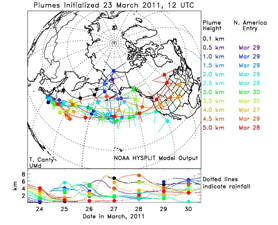More than a week after a 46-foot tsunami devastated parts of northeast Japan, engineers are still working to regain control of a damaged nuclear reactor facility. Reports of higher-than-normal levels of radiation in milk and some vegetables are popping up in areas not far from the Fukushima reactor, and meteorologists have measured small levels of radiation wafting over the United States on very high altitude winds.

Wide Angle: Japan in Crisis
So far, it doesn't appear that anyone living in the United States is in danger. An announcement from the Food and Drug Administration yesterday reported that no products are being exported from the affected region of Japan, since people there are still dealing with the heavy damage from the quake and tsunami. Nonetheless, the agency says it's paying special attention to any shipments that may arrive from companies in the affected area.
But how can you know if any radiated particles are in your local air?
You can watch the winds on the University of Maryland's website, which uses information from NOAA to calculate the movement of hazardous material through the atmosphere.
Or you can visit the website Radiation Network, which reports to the public the radiation levels in most locations throughout the 48 contiguous United States. It's a grass-roots effort managed by backyard radiation watchers equipped with hand-held Geiger counters. Volunteers who sign up for monitoring download a software program developed by Tim Flanegin, who runs the site, and then use the radiation detectors, which are connected to laptops, to upload information in near real time. Read more about do-it-yourself radiation monitoring in this article from the Washington Post.
So far, measured levels over the United States are being reported as very low and harmless, since any radiation gets diluted in the air by wind and rain as it travels across the globe.
Source:
discovery
 More than a week after a 46-foot tsunami devastated parts of northeast
More than a week after a 46-foot tsunami devastated parts of northeast 

 Previous page
Previous page Back to top
Back to top







